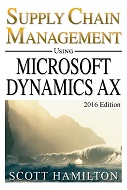S&OP Game Plans with Sales Promotions in Manufacturers Using Microsoft Dynamics 365 for Finance and Operations
Sales promotions often apply to manufacturers of consumer products, but they also apply to other types of firms. The source of a sales promotion may originate internally or from customer initiatives. A typical scenario for a customer-initiated promotion applies to manufacturers selling consumer products into a large chain of retail stores, where the customer provides advance notification of the expected demand for one or more products and the required ship date. These details about expected demand must be estimated for internally-originated promotions such as an ad campaign. In either case, the expected demands often represent a spike in demand for the related product and a master scheduler will need to include them in the item’s S&OP (Sales and Operations Planning) game plans.
Modeling a sales promotion involves several considerations about software capabilities for those firms using Microsoft Dynamics 365 for Finance and Operations (D365FO). For example, a promotion may involve the use of a sales trade agreement to define special pricing and/or discounts. It may involve a campaign or a trade allowance agreement. Additional options apply to firms using the retail capabilities within D365FO. However, whether they are actually used or not, none of the above-mentioned capabilities provide visibility of the promotion’s anticipated demands to support S&OP game plans that drive manufacturing and transfers of the related products. An additional approach is needed to provide visibility of the anticipated demands.
This article describes an approach for modeling sales promotions using demand forecasts, thereby providing visibility of the expected demands. These can be termed promotion forecasts to differentiate them from the normal demand forecasts for products, and they represent one of the key elements in a product’s S&OP game plans. Each promotion forecast has a unique identifier for its forecast model – which is also designated as a submodel of the normal forecast model specified in the master plan policies. In this way, master scheduling logic will consider all demand forecasts for the normal forecast model and its submodels.
Visibility of a promotion’s expected demands to support an item’s S&OP game plans provides the starting point for further explanation, and this article consists of the following sections.
- Promotion Forecasts as part of the S&OP Game Plans for an Item
- Definition of a Forecast Model for each Promotion Forecast ID
- Entries of the Demand Forecasts for a Promotion Forecast ID
- Entries of the Demand Forecasts for an Item
- Example of the item’s Net Requirements information
- Pros and Cons of using Demand Forecasts for Sales Promotions
- Summary
The article extends previous explanations about using demand forecasts for S&OP game plans and master planning in manufacturing. It includes screenshots reflecting the D365FO user interface, but the screenshots could have reflected the user interface in previous software versions of Dynamics AX – such as AX 2012 R3 and AX 2012 -- because the same software functionality applies.
1. Promotion Forecasts as part of the S&OP Game Plans for an Item
Promotion forecasts can represent one of several key elements in a product’s S&OP game plans, which include demands stemming the item’s normal demand forecasts, safety stock requirements and sales orders. To meet these demands, master scheduling logic will generate planned production orders based on the item’s planning data, which can then be firmed to create actual production orders. Figure 1 illustrates these key elements in a typical process to maintain the S&OP game plans for a stocked product. The figure includes swim lanes for the typical roles, including those responsible for identifying and entering the promotion forecasts.

Figure 1: Typical Process to Maintain S&OP Game Plans for a Stocked Product
For our purposes, it is assumed that the demands related to promotion forecasts are not reflected in an item’s normal demand forecasts or in the item’s safety stock requirements. An item’s safety stock requirements typically reflect the needed inventory to anticipate higher-than-forecasted demands and meet customer service levels. A promotion forecast can identify expected spikes in demand that are not reflected in the item’s safety stock requirements. In addition, an item’s normal demand forecasts typically reflect monthly estimates spread into weekly or daily increments. A promotion forecast and its expected ship date(s) can be defined for a specific date.
Sales orders and their promise dates comprise another key element of the S&OP game plans. When entering a sales line for a stocked product, these promised ship dates typically reflect delivery date control based on Available-to-Promise (ATP) logic, as shown at the bottom of Figure 1. Other scenarios employ delivery date control based on sales lead time, and the promised ship date for a sales line reflects the item’s sales lead time.
2. Definition of a Forecast Model for each Promotion Forecast ID
FREE Membership Required to View Full Content:
Joining MSDynamicsWorld.com gives you free, unlimited access to news, analysis, white papers, case studies, product brochures, and more. You can also receive periodic email newsletters with the latest relevant articles and content updates.
Learn more about us here





